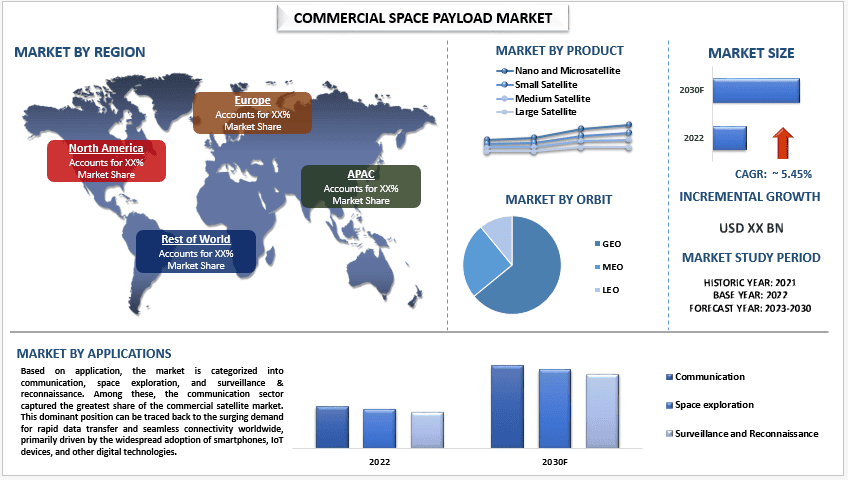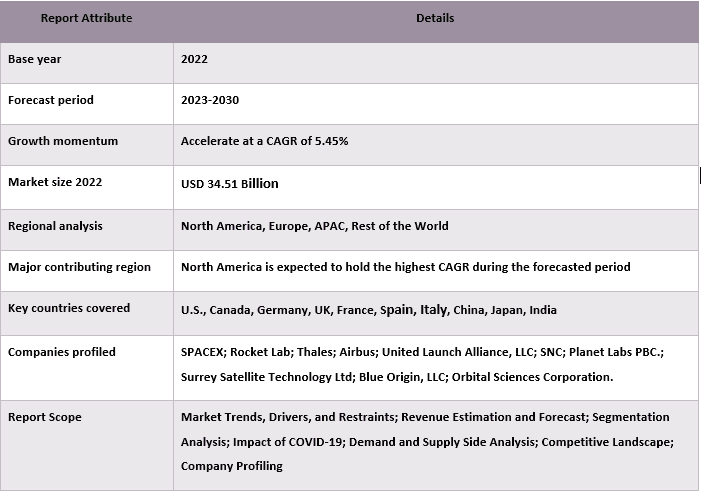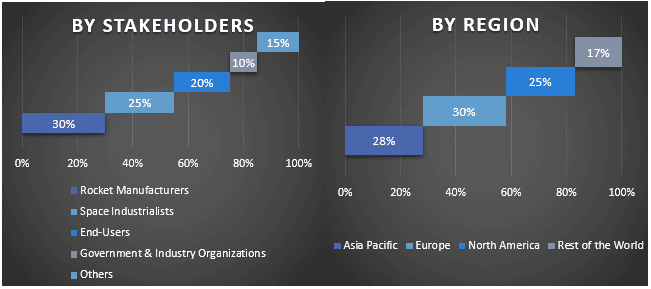- Home
- About Us
- Industry
- Services
- Reading
- Contact Us
Commercial Space Payload Market: Current Analysis and Forecast (2023-2030)
Emphasis on Product (Nano And Microsatellite, Small Satellite, Medium Satellite, And Large Satellite); Orbit (GEO, MEO, and LEO); Application (Communication, Space Exploration, And Surveillance & Reconnaissance) and Region/Country

The Commercial Space Payload Market was valued at 34.51 billion in 2022 and is expected to grow at a steady rate of around 5.45% in the forecasted period (2023-2030). The commercial space payload market refers to the industry involved in providing launch services for satellites, scientific instruments, and other payloads by private, commercial entities. It encompasses the buying and selling of payload space on rockets and launch vehicles for various purposes, such as telecommunications, Earth observation, scientific research, and more. This market has grown with the increasing demand for space-based applications and services from non-governmental entities. Technological advancements and cost reductions in space launch services have made it more accessible for private companies, fostering increased participation in the industry. Also, the rising demand for satellite-based services, such as telecommunications, Earth observation, and global navigation, further stimulates market growth. Additionally, the emergence of new players and competition within the commercial space sector has led to innovative business models and increased launch frequency. For instance, in July 2023, SpaceX developed a reusable first stage for its Falcon 9 rocket, allowing it to land vertically after launch and potentially lowering the cost of access to space by a factor of five or six.
Some of the major players operating in the market are SPACEX; Rocket Lab; Thales; Airbus; United Launch Alliance, LLC; SNC; Planet Labs PBC.; Surrey Satellite Technology Ltd; Blue Origin, LLC; Orbital Sciences Corporation.
Insights Presented in the Report
“Among product, the small satellite segment is currently the leading segment of the market during forecast period.”
Based on product, the market is categorized into nano and microsatellite, small satellite, medium satellite, and large satellite. Among these, the small satellite segment held the largest share of the market. This dominance is attributed to factors such as lower launch costs, shorter development cycles, and increased demand for Earth observation and remote sensing applications. Within the small satellite segment, there has been tremendous growth in constellations like Starlink and OneWeb, providing global internet connectivity through hundreds or thousands of low-Earth orbit satellites. These constellations hold significant potential for future expansion and innovation.
“Among orbit, the LEO segment is currently the leading segment of the market during forecast period.”
Based on orbit, the market is segmented into GEO, MEO, and LEO. Among these, the Low Earth Orbit (LEO) segment is expected to grow at the highest CAGR during the forecast period. The increasing adoption of small satellites and megaconstellations for various applications such as IoT, remote sensing, and communication networks drive this growth. Additionally, government initiatives promoting space exploration and investments in new technologies contribute to the rise of the LEO segment.
“North America holding a significant share of the market.”
North America leads the way when it comes to the Commercial Space Payload Market. The market for commercial space payloads has grown quickly due to several reasons. Private space companies like SpaceX, Blue Origin, and Rocket Lab have brought new ideas and competition to the industry. Governments have also helped with favorable policies and funding. This has led to more demand for satellites that can do things like communicate, watch the earth, and navigate. All these factors have made North America a great place for developing advanced space technology.
Commercial Space Payload Market Report Coverage

Reasons to buy this report:
- The study includes market sizing and forecasting analysis validated by authenticated key industry experts.
- The report presents a quick review of overall industry performance at one glance.
- The report covers an in-depth analysis of prominent industry peers with a primary focus on key business financials, product portfolio, expansion strategies, and recent developments.
- Detailed examination of drivers, restraints, key trends, and opportunities prevailing in the industry.
- The study comprehensively covers the market across different segments.
- Deep dive regional level analysis of the industry.
Customization Options:
The global commercial space payload market can further be customized as per the requirement or any other market segment. Besides this, UMI understands that you may have your own business needs, hence feel free to contact us to get a report that completely suits your requirements.
Table of Content
Research Methodology for the Commercial Space Payload Market Analysis
(2023-2030)
Analyzing the historical market, estimating the current market, and forecasting the future market of the global Commercial Space Payload market were the three major steps undertaken to create and analyze the adoption of visual collaboration platform solutions in major regions globally. Exhaustive secondary research was conducted to collect the historical market numbers and estimate the current market size. Secondly, to validate these insights, numerous findings and assumptions were taken into consideration. Moreover, exhaustive primary interviews were also conducted, with industry experts across the value chain of the global Commercial Space Payload market. Post assumption and validation of market numbers through primary interviews, we employed a top-down/bottom-up approach to forecasting the complete market size. Thereafter, market breakdown and data triangulation methods were adopted to estimate and analyze the market size of segments and sub-segments of the industry pertains to. Detailed methodology is explained below:
Analysis of Historical Market Size
Step 1: In-Depth Study of Secondary Sources:
Detail secondary study was conducted to obtain the historical market size of the Commercial Space Payload Market through company internal sources such as annual reports & financial statements, performance presentations, press releases, etc., and external sources including journals, news & articles, government publications, competitor publications, sector reports, third-party database, and other credible publications.
Step 2: Market Segmentation:
After obtaining the historical market size of the Commercial Space Payload Market, we conducted a detailed secondary analysis to gather historical market insights and share for different segments & sub-segments for major regions. Major segments are included in the report as product, orbit, and application. Further country-level analyses were conducted to evaluate the overall adoption of testing models in that region.
Step 3: Factor Analysis:
After acquiring the historical market size of different segments and sub-segments, we conducted a detailed factor analysis to estimate the current market size of the Commercial Space Payload Market. Further, we conducted factor analysis using dependent and independent variables such as various product, orbit, and application of visual collaboration platform solutions. A thorough analysis was conducted of demand and supply-side scenarios considering top partnerships, mergers and acquisitions, business expansion, and product launches in the Commercial Space Payload Market sector across the globe.
Current Market Size Estimate & Forecast
Current Market Sizing: Based on actionable insights from the above 3 steps, we arrived at the current market size, key players in the global Commercial Space Payload Market, and market shares of the segments. All the required percentage shares split, and market breakdowns were determined using the above-mentioned secondary approach and were verified through primary interviews.
Estimation & Forecasting: For market estimation and forecast, weights were assigned to different factors including drivers & trends, restraints, and opportunities available for the stakeholders. After analyzing these factors, relevant forecasting techniques i.e., the top-down/bottom-up approach were applied to arrive at the market forecast for 2030 for different segments and sub-segments across the major markets globally. The research methodology adopted to estimate the market size encompasses:
- The industry’s market size, in terms of revenue (USD) and the adoption rate of the Commercial Space Payload Market across the major markets domestically
- All percentage shares, splits, and breakdowns of market segments and sub-segments
- Key players in the global Commercial Space Payload Market in terms of products offered. Also, the growth strategies adopted by these players to compete in the fast-growing market.
Market Size and Share Validation
Primary Research: In-depth interviews were conducted with the Key Opinion Leaders (KOLs) including Top Level Executives (CXO/VPs, Sales Head, Marketing Head, Operational Head, Regional Head, Country Head, etc.) across major regions. Primary research findings were then summarized, and statistical analysis was performed to prove the stated hypothesis. Inputs from primary research were consolidated with secondary findings, hence turning information into actionable insights.
Split of Primary Participants in Different Regions

Market Engineering
The data triangulation technique was employed to complete the overall market estimation and to arrive at precise statistical numbers for each segment and sub-segment of the global Commercial Space Payload Market. Data was split into several segments & sub-segments post studying various parameters and trends in the areas of product, orbit, and application in the global Commercial Space Payload Market.
The main objective of the Global Commercial Space Payload Market Study
The current & future market trends of the global Commercial Space Payload Market were pinpointed in the study. Investors can gain strategic insights to base their discretion for investments on the qualitative and quantitative analysis performed in the study. Current and future market trends determined the overall attractiveness of the market at a regional level, providing a platform for the industrial participant to exploit the untapped market to benefit from a first-mover advantage. Other quantitative goals of the studies include:
- Analyze the current and forecast market size of the Commercial Space Payload Market in terms of value (USD). Also, analyze the current and forecast market size of different segments and sub-segments.
- Segments in the study include areas of product, orbit, and application.
- Define and analysis of the regulatory framework for the visual collaboration platform solutions industry.
- Analyze the value chain involved with the presence of various intermediaries, along with analyzing customer and competitor behaviors of the industry.
- Analyze the current and forecast market size of the Commercial Space Payload Market for the major region.
- Major countries of regions studied in the report include Asia Pacific, Europe, North America, and the Rest of the World.
- Company profile of the Commercial Space Payload Market and the growth strategies adopted by the market players to sustain in the fast-growing market.
- Deep dive regional level analysis of the industry
Frequently Asked Questions FAQs
Q1: What is the current market size and growth potential of the global Commercial Space Payload Market?
Q2: What are the driving factors for the growth of the global Commercial Space Payload Market?
Q3: Which segment has the largest share of the global Commercial Space Payload Market by Application?
Q4: Which region will dominate the global Commercial Space Payload Market?
Q5: Who are the key players operating in the global Commercial Space Payload Market?
Related Reports
Customers who bought this item also bought










